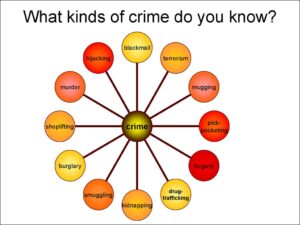Back to: Religion and National Value JSS2
Welcome to class!
In today’s class, we’re going to be talking about Identifying common crimes. I trust you will enjoy the class!
Identifying Common Crimes
Crime is an action or omission that constitutes an offense that may be prosecuted by the state and is punishable by law. Understanding common crimes is crucial for maintaining personal safety and upholding national values.
Types of Common Crimes

- Property Crimes: These involve the theft or destruction of someone else’s property. Examples include:
– Burglary: Breaking into a house to steal.
– Theft: Taking someone’s property without permission.
– Vandalism: Deliberately damaging property.
- Violent Crimes: These involve harm or the threat of harm to others. Examples include:
– Assault: Causing physical harm to another person.
– Robbery: Taking property from someone by force.
– Homicide: The unlawful killing of another person.
- Consensual or Victimless Crimes: These are offenses that do not directly victimize another person. Examples include:
– Illegal Drug Use: Consuming controlled substances.
– Gambling: Participating in unauthorized betting activities.
- White-Collar Crimes: These are financially motivated, non-violent crimes committed by business and government professionals. Examples include:
– Fraud: Deceiving someone for financial gain.
– Embezzlement: Stealing funds that were entrusted to your care.
- Cybercrimes: These involve criminal activities carried out by means of computers or the internet. Examples include:
– Identity Theft: Using someone else’s identity for fraud.
– Hacking: Unauthorized access to data in a system or computer.
Consequences of Crime

– Legal Penalties: Including fines, community service, probation, or imprisonment.
– Social Consequences: Loss of trust, damaged relationships, and community fear.
– Economic Impact: Costs associated with law enforcement, legal proceedings, and rehabilitation.
Preventing Crime
– Awareness: Being informed about common crimes and their warning signs.
– Education: Learning about the law and consequences of criminal behavior.
– Community Programs: Participating in neighborhood watch or youth mentorship programs.
The Role of Individuals
– Reporting Crimes: Informing authorities about criminal activities.
– Supporting Victims: Providing help and empathy to those affected by crime.
– Advocating for Justice: Promoting fair treatment and legal processes.
We have come to the end of today’s class. I hope you enjoyed the class!
In the next class, we shall be discussing safety tips.
In case you require further assistance or have any questions, feel free to ask in the comment section below, and trust us to respond as soon as possible. Cheers!
